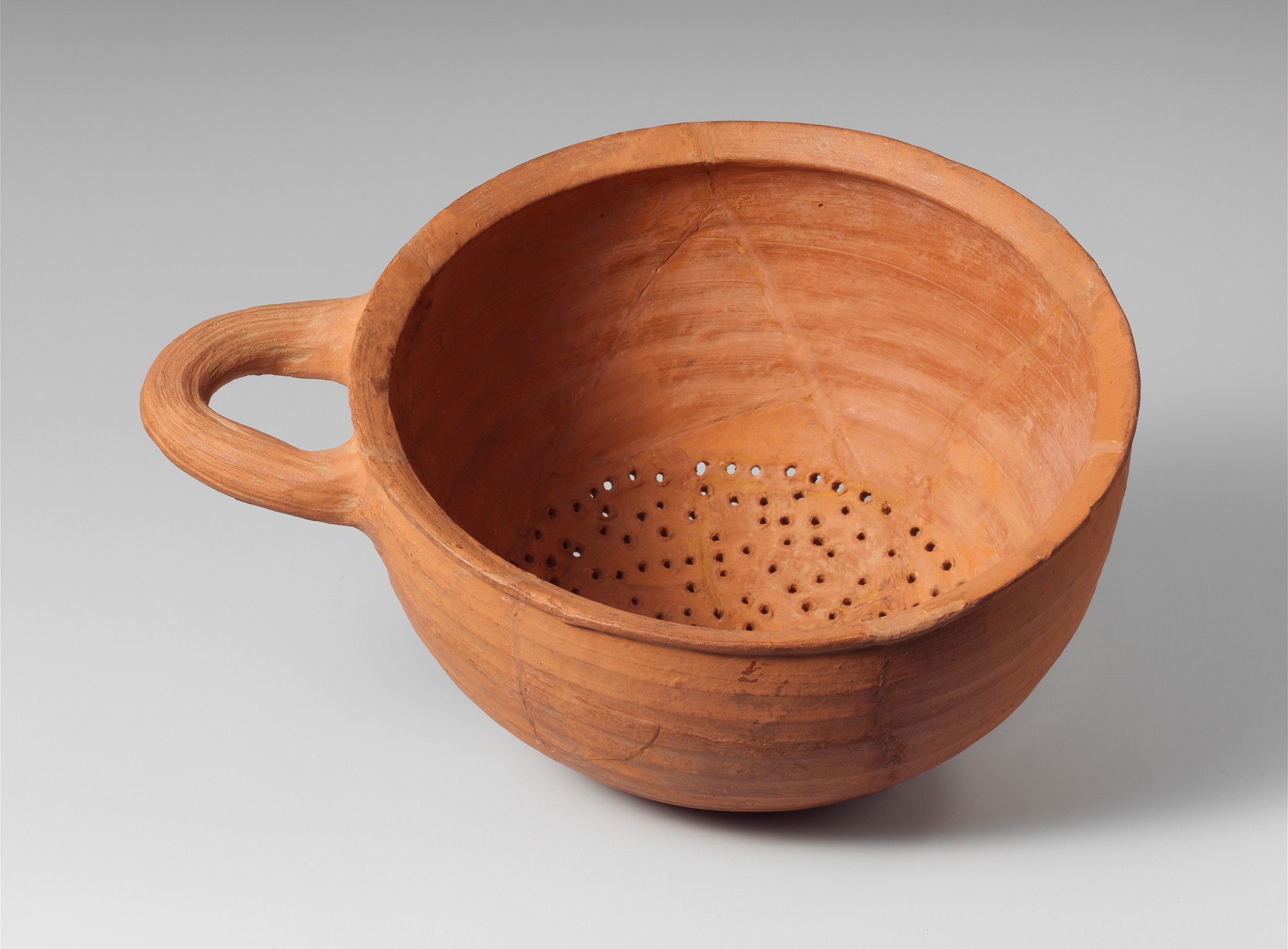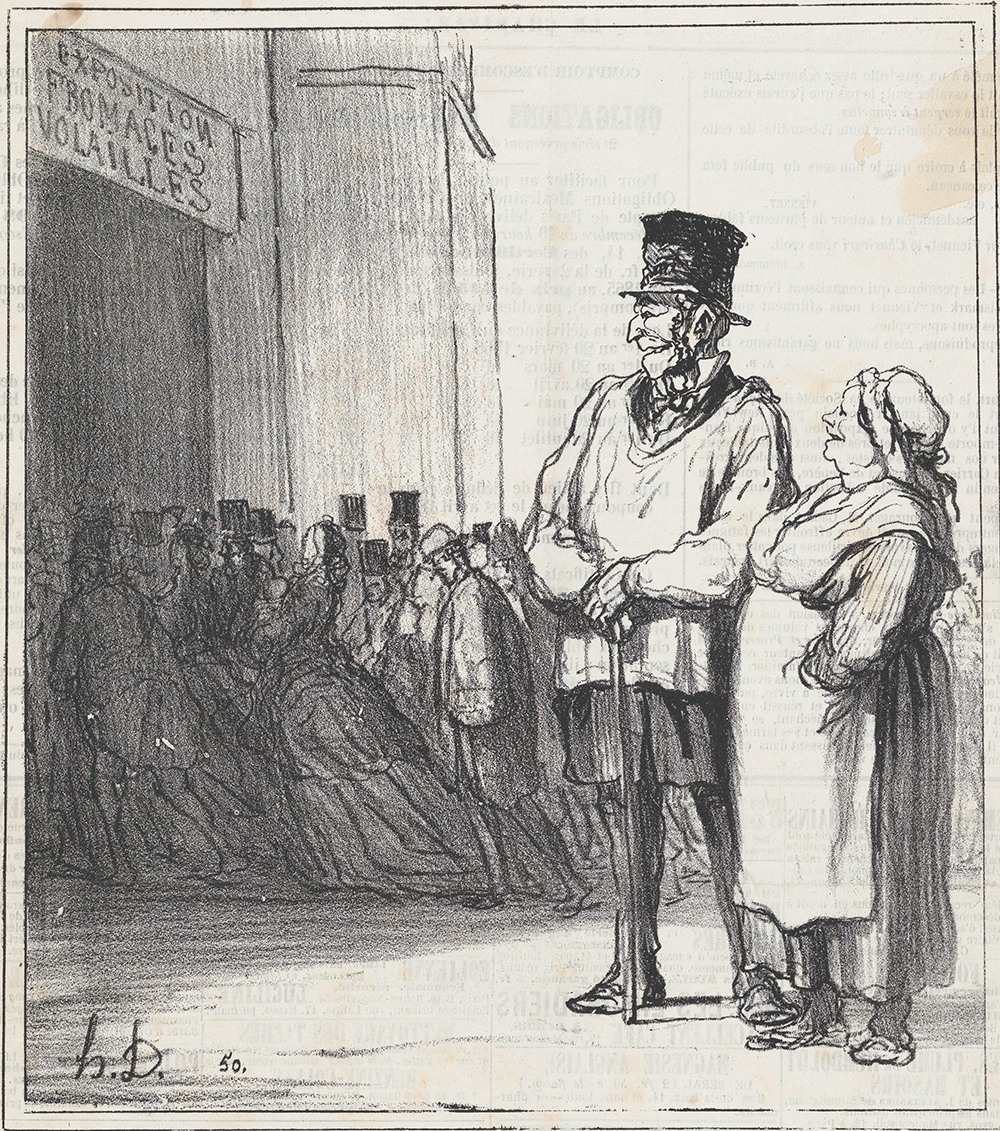
Terracotta hemispherical strainer, sixth century bc. The Metropolitan Museum of Art, Gift of The American Society for the Exploration of Sardis, 1914.
There are a great many apocryphal stories of how milk first came into contact with the butchered innards of an animal, specifically the stomach lining, where the milk quickly curdles. The most ubiquitous stories are of nomads traveling with milk stored in bladders made of animal stomach and then, arriving at their destination, finding that the milk had turned solid. The agent from the animal’s stomach that curdles the milk is known as rennet. The proteins in milk cannot fuse because they are negatively charged, the way the two negative ends of a magnet repel each other. An enzyme in rennet takes away the negative charge and the proteins start to fuse into curds.
To make cheese, the curds were placed in wooden molds with holes and pressed for days until 85 percent of the liquid—a cloudy, highly nutritious water called whey—was squeezed out of the curds. The rennet leaves with the whey. Whey was, and still is, often fed to farm animals. Many human foods were, and are, made from it as well. The ancient Persians used whey to whip and cook into a food they called qaraqorut. The solid cheese that remains after the whey is removed can then be preserved through brining to produce a cheese like the Greek feta, which is one of the oldest cheeses in the world.
In Greek mythology, Aristaio, son of Apollo, invented cheese, which suggests that the Greeks thought cheesemaking important.
The not infrequent references to cheesemaking in Homer present it as a commonplace activity on farms. Homer, whose writings were compilations of already ancient oral histories, twice mentions a dish made of barley meal, honey, Pramnian wine (a strong, dark, high-quality wine), and grated goat’s-milk cheese. Cheese was also central to the Spartan diet. A rite of passage for a boy was to steal a cheese from a household without getting caught.

The ancient Romans also made and cooked with cheese. Marcus Porcius Cato, commonly referred to as Cato the Elder, who lived from 234 to 149 bc, was a conservative Roman politician from an agricultural background who opposed what he saw as a growing tendency toward excessive luxury. His treatise on agriculture, De Agricultura, is the oldest surviving complete book of Latin prose. In it he offers a number of recipes. Here is his mustacei, a simple recipe for a soft fresh cheese made with lard and unfermented must, the juice of wine grapes:
Prepare mustacei thus: Moisten a modius [two gallons, a peck, or a half bushel] of fine flour with must. Add anise, cumin, two pounds of fat, 1 pound of cheese, and a grated bay twig. When you have shaped them, place bay leaves beneath and cook.
Cato’s most famous recipe is for placenta, a kind of cheesecake used in religious ritual.
Make placenta this way: two pounds bread-wheat flour to make the base; four pounds flour and two pounds emmer groats. Turn the emmer into water; when it is really soft turn into a mixing bowl and drain well; then knead it with your hands and when it is well worked add the four pounds flour gradually and make into sheets. Arrange them in a basket to dry out.
When they are dry, rearrange them neatly. In making each sheet when you have kneaded them, press them with a cloth soaked in oil, wipe them round and dampen them.
When they are made, heat up your cooking fire and your crock. Then moisten the two pounds flour and knead it: from this you make a thin base.
Put in water 14 pounds sheep’s milk, not sour, quite fresh. Let it steep, changing the water three times. [Cheese was stored in brine and had to be soaked to be desalinated.] Take it out and squeeze it gradually dry with the hands. When all the cheese is properly dried out, in a clean mixing bowl knead it with the hands, breaking it down as much as possible. Then take a clean flour sieve and press the cheese through the sieve into the bowl. Then take four and a half pounds good honey and mix it well with the cheese.
Then put the base on a clean table that has a foot of space. With oiled bay leaves under it make the placenta.
First put a single sheet over the whole base, then one by one, with the mixture, add them spreading in such a way that you eventually use up all the cheese and honey and on the top put one more sheet by itself. Then draw up the edges of the base having previously stoked up the fire; then place the placenta to cook, cover it with the heated crock and put hot coals around and above it. Be sure to cook it well and slowly. Open to check on it two or three times.
This makes a one-gallon placenta.
The Romans, who often commented on the inferiority of other cultures, took excessive milk drinking as evidence of barbarism. Because milk spoiled quickly in the climate of southern Europe and kept far better in northern Europe, northerners used far more milk. This led southern classical cultures, which were contemptuous of northerners in any event, to take the greater consumption of dairy as evidence of their barbarian nature. During a visit to conquered Britain, Julius Caesar was appalled by how much milk and meat the northerners consumed. Strabo disparaged the Celts for excessive milk drinking and excessive eating in general. Tacitus, when illustrating the crude and tasteless diet of the Germans, singled out their fondness for “curdled milk.”
Anthimus, a sixth-century Greek living in exile in Ostragoth, cautioned that milk was more healthful when not drunk fresh:
If it is for people with dysentery, give goat’s milk prepared by heating round stones in the fire, and then putting these stones into the milk. When the milk boils, take out the stones. Add white well-leavened bread that has been finely sliced and cut up into pieces and cook slowly on the fire. Use an earthenware pot and not a bronze pan. When the milk has boiled and after the bread has become saturated, let the patients eat the pieces with a spoon. Milk is more beneficial served like this, because it is nourishing. If milk is drunk on its own, it passes in contrast straight through and scarcely remains in the body.
Anthimus believed that while fresh cheese was harmless, especially if dipped in honey, cured cheese caused kidney stones and was very unhealthful. He wrote, “Whoever eats baked or boiled cheese has no need of another poison.”
Excerpted from Milk! A 10,000-Year Food Fracas by Mark Kurlansky, published in 2018 by Bloomsbury Publishing. Copyright © 2018 by Mark Kurlansky. Reproduced by permission of Bloomsbury Publishing.